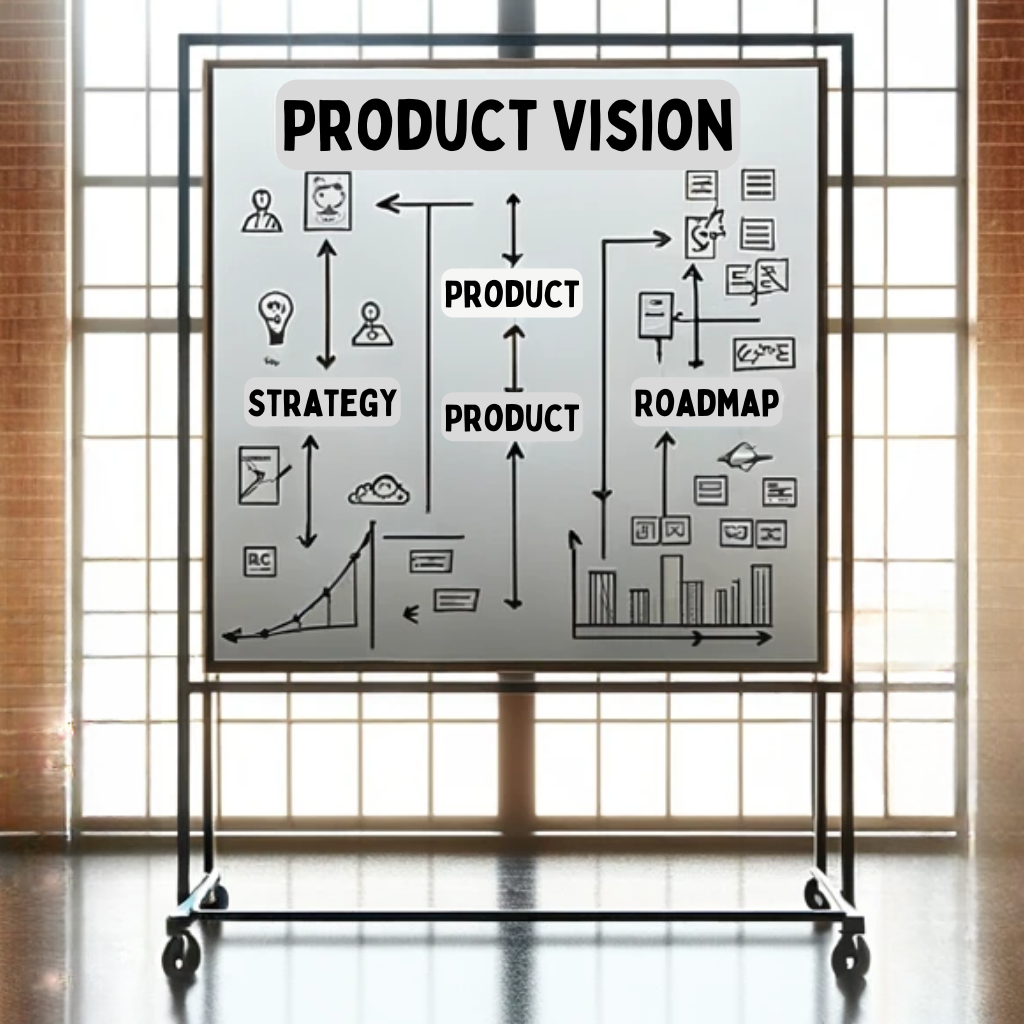A business’s success hinges on its ability to create and implement an effective product strategy. But what exactly makes a product strategy successful? This article explores the five key elements that are essential to unlocking success in product strategy.
TL;DR
- Understanding the Market and Target Audience: A successful product strategy begins with a deep dive into market research and customer insights. Understanding customer preferences and needs is crucial.
- Defining Your Unique Value Proposition: It’s imperative to communicate the superiority of your product over competitors. A strong value proposition attracts and retains customers.
- Developing a Comprehensive Product Roadmap: This involves outlining the stages of product development, including ideation, prototyping, testing, and launch, and aligning these with market trends and customer feedback.
- Effective Product Pricing and Positioning: Pricing should align with value perception and market positioning, while positioning should focus on creating a compelling brand image.
- Launching and Promoting Your Product: An effective go-to-market strategy, from creating awareness to driving sales, is essential for a successful product launch.
How to come up with a product Strategy – 5 Steps
In order to create a winning product strategy, it is crucial to have a deep understanding of the market and target audience. This involves conducting thorough market research and collecting valuable customer insights. By understanding what customers truly need and prefer, businesses can develop products that resonate with their target audience.
1. Understanding the market and target audience
A business’s success hinges on its ability to create and implement an effective product strategy. But what exactly makes a product strategy successful? This article explores the five key elements that are essential to unlocking success in product strategy.
2. Defining your unique value proposition
Market research allows businesses to identify trends, gaps in the market, and areas of opportunity. It involves analyzing customer demographics, psychographics, and behaviors to gain insights into their preferences and pain points. By understanding their customers on a deep level, businesses can create products that truly meet their needs.
Additionally, market research helps businesses identify their target audience, allowing them to tailor their product strategy and marketing efforts accordingly. By understanding who their ideal customers are, businesses can create targeted messaging and positioning that resonates with their audience.
3. Developing a comprehensive product roadmap
A clear and well-defined value proposition is crucial for a winning product strategy. It’s not enough to simply have a great product; businesses must be able to communicate why their product is superior to competitors’ offerings. A strong value proposition can help attract customers and differentiate the product in a crowded market.
A value proposition is a concise statement that communicates the unique benefits and value a product provides to its customers. It answers the question, “Why should customers choose your product over competitors’?” A compelling value proposition addresses the pain points of customers and demonstrates how the product solves their problems better than any other option.
To define a strong value proposition, businesses must first identify their unique selling points. What sets their product apart from competitors? This could be innovative features, superior quality, exceptional customer service, or any other aspect that provides value to customers. Once the unique selling points are identified, they can be crafted into a compelling value proposition that resonates with the target audience.
4. Effective product pricing and positioning
A comprehensive product roadmap is a vital component of a winning product strategy. It provides a clear plan for the development, launch, and ongoing improvement of a product. A well-defined roadmap ensures that all stakeholders are aligned and working towards the same goals.
The product roadmap outlines the timeline, milestones, and key deliverables of the product development process. It includes the different stages of product development, such as ideation, prototyping, testing, and launch. Additionally, the roadmap outlines the resources, budget, and team members involved in each stage.
A well-developed product roadmap also takes into account market trends and customer feedback. It allows businesses to anticipate future needs and plan for product enhancements and updates. By continuously iterating and improving the product based on customer feedback and market trends, businesses can stay ahead of the competition and ensure long-term success.
5. Launching and promoting your product
Product pricing and positioning play a crucial role in the success of a product strategy. Pricing is not just about determining the right price point; it is also about perceived value and positioning in the market.
Pricing should be based on a thorough analysis of costs, competition, and customer willingness to pay. Businesses must consider factors such as production costs, overhead expenses, and desired profit margins. Additionally, it is important to analyze the pricing strategies of competitors to ensure competitiveness in the market.
Positioning is about creating a unique and compelling brand image for the product. It involves identifying the target market segment and positioning the product in a way that resonates with that audience. Businesses must consider factors such as product features, benefits, and brand values when crafting their positioning strategy.
By effectively pricing and positioning the product, businesses can attract the right customers and communicate the value they provide. This helps create a strong market presence and sets the foundation for long-term success.
Monitoring and evaluating product performance
A well-executed go-to-market strategy is critical for successful product launches. From pricing and distribution to marketing and sales, businesses must have a comprehensive plan in place to ensure their product reaches the right audience at the right time.
The first step in launching a product is to create awareness and generate excitement. This can be done through various marketing channels such as social media, email marketing, content marketing, and influencer partnerships. Businesses must create compelling messaging and positioning that resonates with their target audience.
Once awareness is generated, businesses must focus on driving sales and conversions. This involves creating a seamless purchasing experience, providing exceptional customer service, and leveraging various sales channels such as e-commerce platforms and retail partnerships.
Post-launch, businesses must continuously promote and market the product to maintain momentum and drive ongoing sales. This can be done through targeted advertising, customer retention strategies, and ongoing product updates and enhancements.
Adapting and iterating your product strategy
Monitoring and evaluating product performance is crucial for identifying areas of improvement and ensuring long-term success. Businesses must analyze key performance indicators (KPIs) to measure the effectiveness of their product strategy.
KPIs can include metrics such as sales revenue, customer acquisition cost, customer lifetime value, customer satisfaction, and market share. By regularly monitoring these metrics, businesses can identify trends, spot potential issues, and make data-driven decisions to optimize their product strategy.
In addition to quantitative metrics, businesses should also gather qualitative feedback from customers. This can be done through surveys, interviews, and user testing. By understanding customers’ experiences and perceptions, businesses can identify areas for improvement and make necessary adjustments to their product strategy.
Case studies: Successful product strategies
To illustrate the importance of the five key elements of a winning product strategy, let’s take a look at a few case studies of successful product strategies.
Case Study 1: Apple iPhone
Apple’s iPhone is a prime example of a product strategy that incorporates the key elements of success. Apple’s deep understanding of customer needs and preferences allowed them to create a product that revolutionized the smartphone industry. Their clear value proposition, innovative features, and sleek design differentiated the iPhone from competitors’ offerings. The comprehensive product roadmap ensured continuous improvement and evolution, with regular updates and enhancements. Apple’s go-to-market strategy, including strategic pricing, exclusive partnerships, and cutting-edge marketing campaigns, contributed to the iPhone’s success. The monitoring and evaluation of product performance allowed Apple to gather insights and make data-driven decisions to further optimize their product strategy.
Case Study 2: Tesla Model S
Tesla’s Model S is another example of a winning product strategy. Tesla’s understanding of the market and target audience, particularly the growing demand for electric vehicles, allowed them to create a product that met customer needs and preferences. Their unique value proposition of sustainable and high-performance electric vehicles positioned them as an industry leader. Tesla’s product roadmap included continuous innovation, with regular software updates and new features. The effective pricing and positioning of the Model S, targeting the luxury car segment, contributed to its success. Tesla’s go-to-market strategy, including direct sales and a network of charging stations, helped them reach their target audience. Monitoring and evaluating product performance allowed Tesla to gather feedback and improve their product strategy.
Product Strategy Consultant: Enhancing Your Business Approach
A Product Strategy Consultant plays a pivotal role in shaping the success of a product. They bring expert insights, industry knowledge, and strategic planning skills to the table. Consultants analyze market trends, customer behavior, and competitor actions to advise businesses on crafting compelling product strategies.
Why Hire a Product Strategy Consultant?
- Expertise in Market Analysis: They offer specialized skills in market research, identifying gaps, and understanding consumer needs.
- Objective Perspective: Consultants provide an unbiased view, crucial for making informed strategic decisions.
- Innovation and Creativity: With their experience across various industries, consultants can introduce innovative ideas and creative solutions.
- Risk Management: They help in identifying potential risks and developing strategies to mitigate them.
- Efficient Resource Allocation: Consultants assist in prioritizing features and investments, ensuring resources are optimally utilized.
When to Consider a Product Strategy Consultant?
- When launching a new product or entering a new market.
- If your current product strategy is not yielding desired results.
- When needing to stay ahead in a highly competitive market.
- To leverage emerging market trends and technologies effectively.
Read more about Mesh Firm Product Strategy Consultants
Conclusion
The marketplace is constantly evolving, and businesses must adapt their product strategy accordingly. A successful product strategy involves staying ahead of market trends, anticipating customer needs, and constantly evolving the product to meet those needs.
To adapt and iterate the product strategy, businesses must stay informed about industry trends, customer preferences, and technological advancements. This can be done through market research, competitive analysis, and customer feedback.
By continuously gathering insights and analyzing data, businesses can identify opportunities for improvement and make informed decisions about product enhancements, updates, and new features. The ability to adapt and iterate is crucial for staying relevant in a dynamic marketplace and maintaining a competitive edge.
You can check out our podcast Product Disorder to learn more below.
FAQ
What is Product Strategy?
Product strategy is a high-level artefact that outlines how a business will develop, launch, and manage a product to meet its business goals and satisfy customer needs.
Can Product Strategy Evolve Over Time?
Yes, product strategy should be adaptable and evolve based on changing market conditions, customer feedback, and technological advancements.
How Do You Measure the Success of a Product Strategy?
Success can be measured using various KPIs like sales revenue, market share, customer satisfaction, and feedback, to evaluate the effectiveness of the strategy.
What Are Some Examples of Successful Product Strategies?
Examples include Apple’s iPhone and Tesla’s Model S, which demonstrate deep market understanding, clear value propositions, innovative features, and effective go-to-market strategies.


